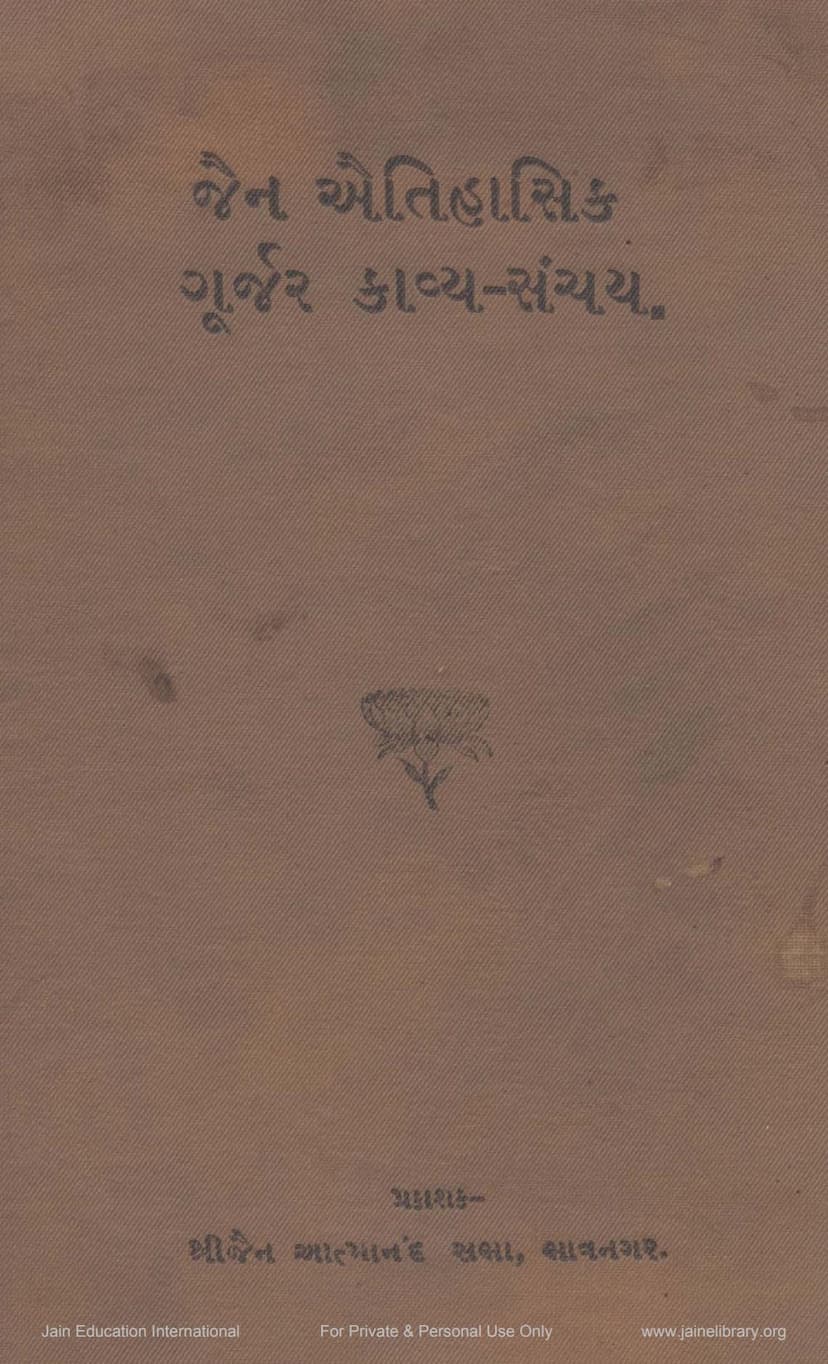Jain Aetihasik Gurjar Kavya Sanchay
Added to library: September 1, 2025

Summary
Here is a comprehensive summary of the Jain text "Jain Aetihasik Gurjar Kavya Sanchay" (Collection of Historical Jain Gujarati Poetry), compiled from the provided pages:
Book Title: Jain Aetihasik Gurjar Kavya Sanchay (જેન એતિહાસિક ગૂર્જર કાવ્ય-સંચય) Author: Jinvijay (જિનવિજયજી) Publisher: Shrijen Atmanand Sabha, Bhavnagar (શ્રી જૈન આત્માનંદ સભા, ભાવનગર) Publication Year: Vikram Samvat 2452 (વિ. સં. ૨૪૫૨), Corresponding to 1926 CE (ઈસ્વી સન ૧૯૨૬)
Overall Purpose and Content:
"Jain Aetihasik Gurjar Kavya Sanchay" is a significant compilation and scholarly presentation of ancient Jain poetry written in the Gujarati language. The primary goal of this collection is to illuminate and preserve the historical, religious, social, and political aspects of Jainism and Gujarati culture from the 13th century up to the early 20th century. It aims to showcase the rich literary contributions of Jain ascetics (sadhus and sadhvis) and lay followers to the Gujarati literary heritage.
Key Aspects and Contributions:
-
Preservation of Ancient Literature: The book brings together thirty-three poems related to thirty-one individuals. These poems are diverse in genre, including padas, bhas, ras, phaga, prabandh, sajhay, stuti, and vivahalau. This collection serves as a vital source for understanding the evolution of the Gujarati language and literary forms over several centuries (13th to early 20th).
-
Historical Insight: The poems, being biographical in nature, offer valuable insights into the lives, teachings, and societal contexts of the individuals they describe. They provide information about religious practices, societal customs, rituals, modes of thinking, and the socio-political conditions of the times. The compilers emphasize that readers should not expect fantastical elements or complex narratives from these historical accounts but rather focus on the factual information presented.
-
Focus on Jain Acharyas and Scholars: A significant portion of the collection comprises the biographies and compositions of Jain Acharyas (monks), Sadhvis (nuns), and prominent Jain householders. This highlights the intellectual and spiritual contributions of the Jain monastic order to literature and history. The text specifically mentions the inclusion of compositions by enlightened women saints (sadhvis), which is noted as a joyful aspect of the compilation, as such records are rare.
-
Scholarly Effort and Collaboration: The book is a result of dedicated efforts in research and editing. Shri Jinvijayji is credited as the main collector and editor. However, the preface acknowledges the significant contributions of other scholars:
- Vakil Mohan Lal Lallubhai Desai, B.A., LL.B. and Vakil Keshavlal Premchand Modi, B.A., LL.B. contributed to the research and summarization of some rasas.
- Chhotalal Maganlal Shah (from Jhulasan) prepared the introductory section (upaghat) and appendices (parishishth).
- Pandit Lalchandra Bhagwandas Gandhi meticulously prepared the final and most substantial part of the book (pages 113-176), including research and compilation, for which he is specially thanked for his selfless dedication.
-
Linguistic and Literary Analysis: The preface, written by Chhotalal Maganlal Shah, provides a detailed analysis of the language and literary aspects of the poems. He discusses:
- Language Evolution: How the Gujarati language evolved over time, with original Sanskrit words adapting into Prakrit and then into the regional vernaculars prevalent in different regions of Gujarat.
- Influence of Vernaculars: The impact of rural dialects on Jain poetry due to the itinerant nature of Jain monks and their need to communicate with common people.
- Distinguishing Jain Literature: The misconception that Jain literature is a separate linguistic entity is addressed. It is clarified that it is fundamentally ancient Gujarati literature, but with a distinct Jain style and vocabulary derived from Sanskrit, Prakrit, and Apabhramsa.
- Literary Merit: While acknowledging that not all poems may possess high literary artistry, the focus is on their historical and linguistic value. The editor emphasizes that the poetic quality is dependent on the poet's genius, but the language and its evolution are crucial aspects for study.
-
Historical Context and Jain Society: The text underscores the importance of Jain literature as a source for understanding Gujarat's history, particularly its social, national, and religious conditions, people's ideologies, and caste structures. It highlights that Jain literature contains more historical material than non-Jain literature for Gujarat's history.
-
Encouragement for Further Research: The publishers and editors express a hope that historians and literature lovers will review this work, appreciate the efforts of the authors, researchers, and publishers, and encourage them to publish more such valuable works.
-
Structure of the Book: The book includes a table of contents (anukramanika), a list of rasas with their summaries (ras-sar-suchi), an appendix listing saints and personalities mentioned in the poems (parishishth no. 1: Kavyantargat sadhuni namavali), and another appendix of places (parishishth no. 2: Kavya antaragat gaHani namavali).
Significance:
This "Jain Aetihasik Gurjar Kavya Sanchay" is more than just a collection of poems; it's a scholarly gateway into a specific period of Jain history and Gujarati literature. It demonstrates the dedication of the Jain community and scholars like Jinvijay, Chhotalal Maganlal Shah, and Lalchandra Bhagwandas Gandhi in preserving and presenting valuable historical and literary treasures. The detailed index and appendices make it a valuable resource for researchers and scholars interested in Jainology, medieval Gujarati literature, and Gujarat's social and religious history.